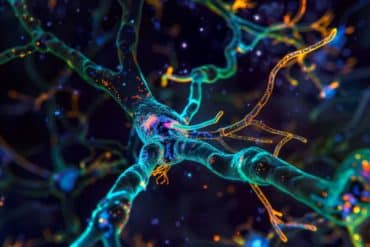Summary: Following training, the brain’s visual center can suppress neuronal responses to pop-out distractors that are usually enhanced compared to other, non-distracting stimuli.
Source: KNAW
Have you ever found yourself searching for your keys or phone only to end up getting distracted by a brightly colored object that grabs your attention?
This type of attentional capture by objects that stand out from their surroundings is known as ‘pop-out’. Pop-out is often functional, for instance when we want people to pay attention to bright red road signs. It can however also distract us from our goals, for instance when a brightly colored binder prevents us from finding our keys on a cluttered desk.
Would it not be nice if pop-out for distracting items could somehow be blocked or suppressed to avoid distractions and help us find whatever we are looking for faster?
New research from the Vision and Cognition group at the Netherlands Institute for Neuroscience, published in PNAS, demonstrates that this is indeed possible. After training, the visual brain can suppress neuronal responses to pop-out distractors that are usually enhanced compared to responses to other, non-distracting, items.
The researchers trained monkeys to play a video game in which they searched for a unique shape among multiple items, while a uniquely colored item tried to distract them. As soon as the monkeys found the unique shape, they made an eye movement to it to indicate their choice.

After some training, monkeys became very good at this game and almost never made eye movements to the distractor.
Neurons in area V4 of the visual cortex, a brain area that processes visual information relatively early after is is captured by the eyes, showed consistently enhanced responses to the shape target stimuli.
Responses to the distracting color stimuli on the other hand were only very briefly enhanced but became rapidly suppressed. It appears that the brain first briefly detects the presence of the distracting stimulus, and then quickly suppresses it to avoid that it will interfere with the search for the shape target.
The color pop-out signal that might cause distraction is thus essentially inverted into a kind of negative pop-out, or “pop-in”, to avoids distraction.
Researcher Chris Klink: “Choosing what to attend to is very important for visual perception, and behavior in general. Even though the brain has impressive processing power, it simply cannot handle all available information at once. Attention needs to strike a balance between our own internally generated goals and whatever appears to be important in the environment.
“Dealing with distraction in an efficient way is a crucial aspect of that process, that we now understand a little bit better”.
About this visual neuroscience research news
Author: Eline Feenstra
Source: KNAW
Contact: Eline Feenstra – KNAW
Image: The image is in the public domain
Original Research: Closed access.
“Inversion of pop-out for a distracting feature dimension in monkey visual cortex” by Chris Klink et al. PNAS
Abstract
Inversion of pop-out for a distracting feature dimension in monkey visual cortex
During visual search, it is important to reduce the interference of distracting objects in the scene. The neuronal responses elicited by the search target stimulus are typically enhanced. However, it is equally important to suppress the representations of distracting stimuli, especially if they are salient and capture attention.
We trained monkeys to make an eye movement to a unique “pop-out” shape stimulus among an array of distracting stimuli.
One of these distractors had a salient color that varied across trials and differed from the color of the other stimuli, causing it to also pop-out. The monkeys were able to select the pop-out shape target with high accuracy and actively avoided the pop-out color distractor.
This behavioral pattern was reflected in the activity of neurons in area V4. Responses to the shape targets were enhanced, while the activity evoked by the pop-out color distractor was only briefly enhanced, directly followed by a sustained period of pronounced suppression.
These behavioral and neuronal results demonstrate a cortical selection mechanism that rapidly inverts a pop-out signal to “pop-in” for an entire feature dimension thereby facilitating goal-directed visual search in the presence of salient distractors.






